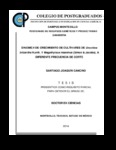| dc.description.abstract | El objetivo del estudio fue determinar la producción estacional y anual de forraje, composición morfológica, características estructurales y dinámica de ahijamiento de praderas de pasto Insurgente, Toledo, Tanzania y Mombaza, cosechados a tres frecuencias de corte (FC; 4, 5 y 6 semanas), durante las épocas de nortes, sequía y lluvias. Se utilizó un diseño de bloques completos al zar, con cuatro repeticiones y arreglo de tratamientos en parcelas divididas, donde la parcela mayor fueron los cultivares y la menor las frecuencias de corte. Los cultivares se sembraron a distancia de 50 x 50 cm entre plantas y surcos, respectivamente. El tamaño de parcelas fue de 10 m2. El área de muestreo fueron los dos surcos centrales, los cuales se dividieron en 3 subparcelas de 1 m2, se dejaron dos macollos entre cada subparcela en los extremos de los surcos centrales. Todos los pastos evaluados presentaron mayor dinámica en la acumulación de forraje y ahijamiento durante la época de lluvias. La mayor acumulación de forraje se obtuvo con la FC de 6 semanas, donde el mayor valor (13, 279 kg MS ha-1) se registró en Tanzania, seguido de Insurgente, Mombaza y Toledo, con promedio de 11, 337, 11, 237 y 10, 713 kg MS ha-1, respectivamente. El pasto Tanzania también presentó la mayor tasa de crecimiento, con 37 kg de MS ha-1 día-1, seguido de Insurgente, Mombaza y Toledo, con valores de 32, 31 y 29 kg MS ha-1 día-1, respectivamente. La mayor proporción de hojas se obtuvo con Mombaza y Tanzania con valores de 93 y 92 %, respectivamente y la menor cantidad de hoja se registró para Toledo (85 %). La mayor altura de planta fue para Mombaza (50 cm), seguido de Toledo, Tanzania e Insurgente, con valores de 46 43 y 35 cm, respectivamente. La proporción de hoja disminuyó de la frecuencia de corte de 4 a 6 semanas. Para mejorar la eficiencia en la producción de forraje y disminuir la acumulación de tallo, la frecuencia de corte recomendada es: en Insurgente y Toledo cada 5 semanas, durante las tres épocas; en Mombaza cada 4, 4 y 5 semanas, en Tanzania cada 5, 5 y 5 semanas, durante la época de nortes, sequía y lluvias, respectivamente. _______________ REGROWTH DYNAMICS OF CULTIVARS OF Urochloa brizantha Kunth, AND Megathyrsus maximus (Simon & Jacobs), TO DIFFERENT CUTTING FRECUENCY. ABSTRACT: The objective of the study was to evaluate the seasonal and annual production herbage, morphological composition, structural characteristics and dynamics of tillering of swards grass Insurgente, Toledo, Tanzania and Mombaza, harvested at three frequencies (FC, 4, 5 and 6 weeks), during the norts, drought and rains. A complete randomized block design was used, with four replicates and split plots treatments arrangement, where the main plot were the cultivars and the lower the cutting frequencies. Cultivars were planted within distance of 50 x 50 cm between plants and rows, respectively.The size of plots was 10 m2.The sampling area were the two central rows, which were divided into 3 subplots of 1 m2, two tillers were left between each subplot on the ends of the central rows. All the evaluated grasses showed greater dynamics in the herbage accumulation and tillering during the rainy season. Greater herbage accumulation was obtained with the FC of 6 weeks, where the highest value (13, 279 kg DM ha-1) was recorded in Tanzania, followed by Insurgente, Mombaza and Toledo, with average of 11, 337, 11, 237 and 10, 713 kg DM ha-1, respectively. Pasture Tanzania also presented the highest rate of growth, with 37 kg DM ha-1 day-1, followed by Insurgente, Mombaza and Toledo, with values of 32, 31 and 29 DM kg ha-1 day- 1, respectively. The highest proportion of leaves was obtained with Mombaza and Tanzania with values of 93 and 92%, respectively, and the least amount of leaf was recorded for Toledo (85%). Greater plant height was to Mombaza (50 cm), followed by Toledo, Tanzania and Insurgente, with values of 46, 43 and 35 cm, respectively. The proportion of leaves decreased from the cutting frequency of 4 to 6 weeks. To improve efficiency in the production of fodder and reduce the accumulation of stem, the preferred cutting frequency is: in Insurgente and Toledo every 5 weeks, during the three seasons; in Mombaza every 4, 4 and 5 weeks in Tanzania every 5, 5 and 5 weeks, during the period of norts, drought and rainfall, respectively. | en_US |


